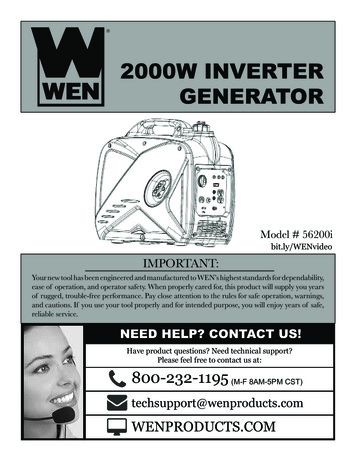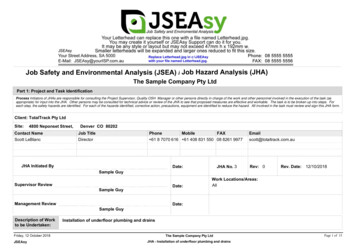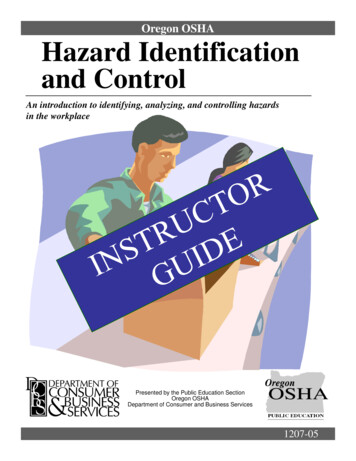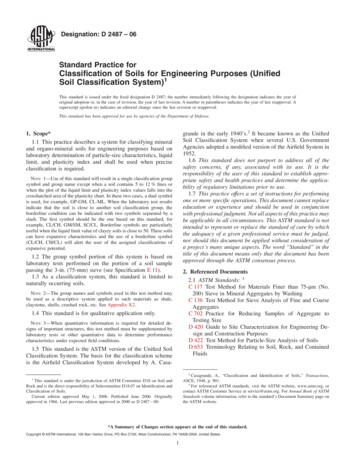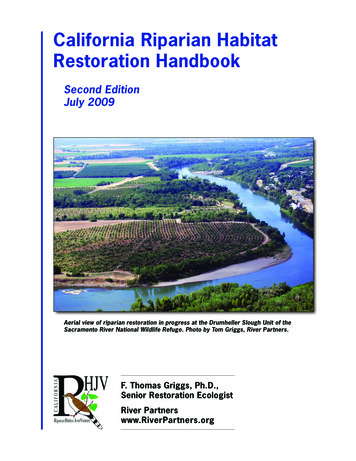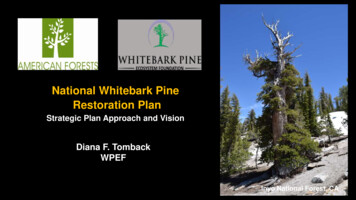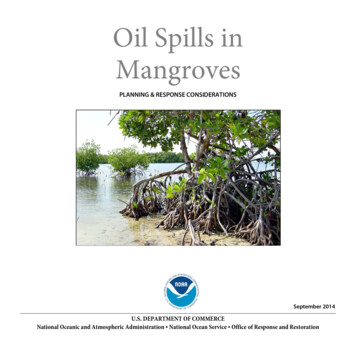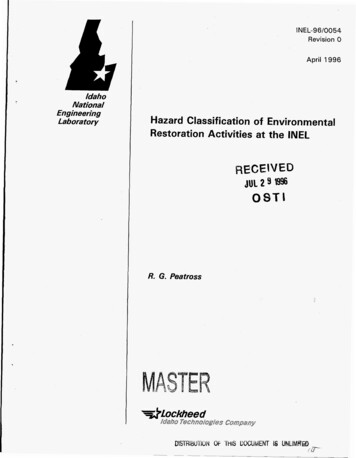
Transcription
I NEL-9 6/0054Revision 0April 1996IdahoNations/EngineeringLaboratoryHazard Classification of EnvironmentalRestoration Activities at the INELECEIVE3UL 2 9 El9609TCR. G. Peatross
INEL-96/0054Revision 0Hazard Classification forEnvironmental Restoration Activitiesat the INELR. G. PeatrossPublished April 1996Idaho National Engineering LaboratoryLockheed Martin Idaho TechnologyIdaho Falls, Idaho 83415Prepared for theU.S. Department of EnergyUnder DOE Idaho Operations OfficeContract DE-AC07-941D13223
Hazard Classification ofEnvironmental Restoration Activitiesat the INELINEL-9610054Revision 0Prepared by:v-R. G. PeatrossChemical and Radiological Risk AssessmentsApproved by:. L. FalconerEnvironmental RestorationDate
DISCLAIMERPortions of this document may be illegiblein electronic image products. Images areproduced from the best available originaldocument.
ABSTRACTThis report presents the results of the hazard classification forenvironmental restoration of sites at the INEL. The hazard classificationis based upon the approach recommended in Hazard BaselineDocumentation (DOE-EM-STD-5502-94).DISCLAIMERThis report was prepared as an account of work sponsored by an agency of the United StatesGovernment. Neither the United States Government nor any agency thereof, nor any of theiremployees, makes any warranty, express or implied, or assumes any legal liability or responsibility for the accuracy, completeness, or usefulness of any information, apparatus, product, orprocess disclosed, or represents that its use would not infringe privately owned rights. Reference herein to any specific commercial product, process, or service by trade name, trademark,manufacturer, or otherwise does not necessarily constitute or imply its endorsement, recommendation, or favoring by the United States Government or any agency thereof. The viewsand opinions of authors expressed herein do not necessarily state or reflect those of theUnited States Government or any agency thereof. .111 -
iv
EXECUTIVE SUMMARYThe following documents require that a hazard classification be prepared forall activities for which United States Department of Energy (DOE) has assumedenvironmental, safety, and health responsibility: The DOE Order 5481. lB,Safety Analysis and Review System and DOE Order 5480.23, Nuclear SafetyAnalysis Reports. A hazard classification defines the level of hazard posed byan operation or activity, assuming an unmitigated release of radioactive andnonradioactive hazardous material.For environmental restoration activities, the release threshold criteriapresented in Hazard Baseline Documentation (DOE-EM-STD-5502-94) areused to determine classifications, such as Radiological, Nonnuclear, and OtherIndustrial facilities.Based upon DOE-EM-STD-5502-94, environmental restoration activities inall but one of the sites addressed by the scope of this classification (see Section2) can be classified as "Other Industrial Facility. " DOE-EM-STD-5502-94states that a Health and Safety Plan and compliance with the applicableOccupational Safety and Health Administration (OSHA) standards are sufficientsafety controls for this classification.V
vi
CONTENTS.ABSTRACT . . . . . . . . . . . . . . . . . . . . . . . . . . . . . . . . . . . . . . . . . . . . . . . . . . . . . . . .111EXECUTIVE SUMMARY . . . . . . . . . . . . . . . . . . . . . . . . . . . . . . . . . . . . . . . . . . . . . .v1. INTRODUCTION . . . . . . . . . . . . . . . . . . . . . . . . . . . . . . . . . . . . . . . . . . . . . . . . . .12 . ACTIVITY DESCRIPTION . . . . . . . . . . . . . . . . . . . . . . . . . . . . . . . . . . . . . . . . . . .23. HAZARD CLASSIFICATION APPROACH . . . . . . . . . . . . . . . . . . . . . . . . . . . . . . . .44. HAZARD CLASSIFICATION . . . . . . . . . . . . . . . . . . . . . . . . . . . . . . . . . . . . . . . . . .65 . REFERENCES . . . . . . . . . . . . . . . . . . . . . . . . . . . . . . . . . . . . . . . . . . . . . . . . . . . .7Appendix A-Contaminants and Sum-of-the-Ratio Calculations . . . . . . . . . . . . . . . . . . . . . . .A- 1FIGURE1. Hazard classification process from DOE-EM-STD-5502-94 . . . . . . . . . . . . . . . . . . . . . . .5TABLE1. Summary of WAGS encompassed by this classification . . . . . . . . . . . . . . . . . . . . . . . . . .vii3
Hazard Classificationof Environmental Restoration Activitiesat the INEL1. INTRODUCTIONUnited States Department of Energy (DOE) Order 5481.1B, Safety Analysis and Review System'and DOE Order 5480.23, Nuclear Safety Analysis Reports2 require that a hazard classification beprepared for all activities for which DOE has assumed environmental, safety, and health responsibility.A hazard classification defines the level of hazard posed only by potential releases of radiological andnonradiological hazardous materials from an operation or activity, assuming no mitigating systems areavailable.DOE-EM-STD-5502-94 classifies facilities and activities as Nuclear, Nonnuclear, Radiological,and Other Ind strial. The classifications are based only on the releasable quantity thresholds listed in40 CFR 302,4DOE-STD-1027-92,5 29 CFR 1910.119,6and 40 CFR 355.71
2. ACTIVITY DESCRIPTIONThis classification is intended to envelop restoration activities performed by EnvironmentalRestoration (ER) and their subcontractors. The majority of these activities take place outdoors andinvolve working with relatively small volumes of liquid, soil, and waste that may be contaminated withradionuclides, chemicals, or both.ER activities are under the management of the ER directorate organization. The waste areagroups (WAGS) and the areas that comprise each WAG are identified in Table 1. Some ER activitiesare excluded from using this hazard classification. Activities that are excluded include:Radioactive Waste Management Complex (RWMC), which has a Safety Analysis Report(SAR) that addresses activities inside the RWMC fenceAreas where unexploded ordnance are presentAny activity for which nuclear criticality has been identified as a valid concern.Characterization activities include soil sampling; well drilling; liquid sampling from wells, ponds,or tanks; and sediment sampling from ponds, tanks, or the ground surface. These activities include awide variety of accepted sampling methods and matrices and typically involve small volumes ofmaterial.Remediation activities include soil removal using earthmoving equipment (backhoe, front-endloader, etc.) or by hand; cleanup of contaminated liquids; removal of waste (mixed) from undergroundstorage tanks (USTs), in situ grouting of USTs, removal of USTs; and capping and monitoring ofcontaminated sites.During ER activities, health and safety protection will be implemented by the Health and SafetyPlan (HSP) written for each ER activity. The HSP provides specific guidelines to minimize health andsafety risks to the worker and public. The HSPs are prepared in accordance with 29 CFR 1910.120,Hazardous Waste Operations and Emergency Response.2
Table 1. Summary of WAGS encompassed by this classification.WAG1FacilityTest Area North (TAN)RemarksIncludes:Technical Support Facility (TSF)Initial Engine Test (IET) FacilityContainment Test Facility (CTF)Specific Manufacturing Capability (SMC) FacilityWater Reactor Research Test Facility (WRRTF).2Test Reactor Area (TRA)Includes several deactivated reactors, the Advanced TestReactor and associated buildings, warm, cold, and sanitarywaste ponds located outside the fence line, and theretention basin inside the fence line.3Idaho Chemical Processing Plant(ICPP)Includes reprocessing facilities for defense and researchspent fuels.4Central Facilities Area (CFA)General support facility for the INEL.5Power Burst Facility (PBF)/Auxiliary Reactor Area ( A M )Includes several test reactors, some of which have beenpartially or completely decontaminated and decommissioned.6Experimental Breeder Reactor-I/Boiling Water ReactorExperiment (EBR-IBORAX)Includes areas within the EBR-I and BORAX sites.7RWMCIncludes activities outside the RWMC facility fence only.10Miscellaneous sitesIncludes miscellaneous surface sites and liquid disposalareas not included within other WAGS.D&DD&D Program facilitiesIncludes all aspects of D&D3
3. HAZARD CLASSIFICATION APPROACHFigure 1 shows the DOE-EM-STD-5502-94 classification process recommended by DOE for allenvironmental management activities. This process was used to determine the appropriate hazardclassification for ER activities.The hazard classification process requires the following: (a) the contaminants and corrcspondingthreshold quantities (TQs) in DOE-STD-1027, reportable quantities (RQs) in 40 CFR 302 Appendix Bfor radioisotopes and Table 40 CFR 302 for nonradioactive hazardous materials be identified, (b) anestimate of the quantities of Contaminants at the remediation or characterization area, (c) a determinationof the ratio of the assumed quantities to the TQs and RQs, (d) a sum of the ratios, (e) an adjustment ofthe sum of the ratios by a ratio of 1E-03 (the most conservative release fraction used to determine theTQs and R Q s ) to a less conservative but defensible release fraction, and (f) use the actual releasefractions found in Reference 8 for each radioisotope if 1.OE-03 is too conservative for a site. Severalconservative assumptions were used in arriving at the sum-of-the-ratios to ensure the enveloping of ERactivities addressed by this hazard classification. These assumptions are discussed in the followingparagraphs.The data tables in Appendix A list the contaminants, the assumed concentrations in soiVwaste andwater, the associated TQs and RQs, and the adjusted sums of the ratios. The list of contaminants and theassumed concentrations are an aggregate of the maximum concentrations of recorded sample analysisresults recorded for WAGS addressed by this hazard classification (see Section 2).9It is assumed that the release volumes are 1 m3 of soillwaste and 4,000 L of water. The assumedvolumes are high for characterization activities and most remediation activities and results in a muchlarger airborne release of material than would be expected. These assumed volumes will bound activitiescurrently planned by ER for calender year 1996.The release fraction for contaminated liquids is assumed to be the same as for contaminated soil.This assumption results in a much larger airborne release of material for a liquid than would beexpected.When summing the ratios, it is assumed that a single restoration activity will involve all thecontaminants found to date and at the maximum concentrations measured to date. These conditions areassumed only to ensure that ER activities are enveloped by this hazard classification. The list ofcontaminants and the assumed concentrations should not be used as screening thresholds to determine iffuture ER activities are enveloped by this classification.The hazard classification is segregated for operable units that because of high concentrations ofcontaminants result in radiological or nuclear facility hazard classifications rather than standardindustrial.4
PreliminaryHazardsIdentificationnPotentially ReleasableRadiation Meets orExceeds DOE-STD1027, Attachment 1APotentially ReleasableRadiation RQ Meetso r Exceeds40 CFR 302,Potentially ReleasableHazardous ChemicalRQ Meets or Exceeds40 CFR 302. Table40 CFR 302.4 LevelsNvI:OTHER acility with NonNuclear FacilityDocumentationNON-N UCLEARFACILITIES**RADIOLOGICALFAC ILlTlES **.!TSRs perr11Develop aNuclear SafetyAnalysis ReportPotentially ReleasableHazardous MaterialBelow 29 CFRY 1910.119 Or40 CFR355 ThresholdsSgsi-i ADDrOpriak: Rocumen!athAuditableSafety Analysis: - Safety Analysis orASA (DOE 5481.16) also ;j principles and requirements!i of Process SafetyManagement (if at ori i above 29 CFR 1910.119);Plan (HASP)DOE 5480.22USQs per-NUCLEARFAC ILlTlES **Sianificant Hazards-ADoroorlate-Safety Analysis Report(DOE 5480 23) alsoprinciples and requirementsof Process SafelyManagement (if at orabove29 CFR 1910 119)Plan (HASP).** Other types of safety and health hazard identification and control documentation may be necessary such as construction safety requirements, ChernicaiHygiene Plans. and Hazcomm. All facilities with hazardous waste activities require a HASP as defined in 29 CFR 1810.12D(a).Figure 1 Hazard classification process from DOE-EM-STD-5502-94.5
4. HAZARD CLASSIFICATIONThe sum of the ratios of releasable quantities compared to the TQs and RQs is less than 1.O for alloperable units (OUs) addressed by this hazard classification except OU 3-07 (see Appendix A).Therefore, ER activities in areas other than OU 3-07 and not excluded from this classification (seeSection 2) may be classified as “Standard Industrial” and an auditable safety analysis or SAR is notneeded.Assuming a release volume of 1 m3, and the actual release fractions found in Reference 8, the sumof the ratios for OU 3-07 is less than one when compared to the TQs but is greater than one (actual valueis two) when compared to the RQs. This site may still be classified as “Standard Industrial” only if theactual volume of potentially releasable soil is less than the volume assumed in the calculations; otherwiseit is classified as ‘‘ Radiological.”Excluding OU 3-07, the sum of the ratios will be less than one for the TQs and RQs even if theassumed volume of soil/waste or water contains all the radioactive and nonradioactive hazardousmaterials at the maximum (assumed) concentrations measured to date (1/96) for soil/waste and waterAdding the sums of the ratios for soil/waste and liquids equals 6E-04 when considering the TQs only(applies only to radionuclides) and 6E-0 1 when considering the RQs (radionuclides and hazardousmaterials). Therefore, the hazard classification will be “Standard Industrial.”This classification is conservative in the extreme and will envelope all typical characterizationactivities and most remediation activities at the INEL. The LMIT Chemical and Radiological RiskAssessment Department (CRRAD) should be consulted for all remediation activities to ensure that theyare enveloped and for characterization activities involving large volumes of materials in a singlecontainer. Activity specific sum-of-the-ratio determinations may be required if there is a potential for aspill of volumes significantly greater than (Le., a factor of two) 1 m3 for soils and wastes and 4,000 L forliquids. It must be noted that the volumes assumed in an activity-specific determination relate only tomaterial spilled in a single event, not the total volume of material stored at a site, involved in a remedialaction, or that may be spilled over the course of an action.This hazard classification will be updated yearly by the CRRAD to include new sample data and toensure that the assumed concentrations are still bounding.6
5. REFERENCES1.U.S. Department of Energy, DOE Order 5481. lB, "Safety Analysis and Review System,"September 23, 1986.2.U. S. Department of Energy, DOE Order 5480.23, "Nuclear Safety Analysis Reports, April 30,1992.3.U. S. Department of Energy, "Hazard Baseline Documentation," DOE Limited Standard,DOE-EM-STD-5502-94, August 1994.4.40 CFR 302.4, "Designation of Hazardous Substances.5.DOE-STD- 1027-92, "Hazard Classification and Accident Analysis Techniques for Compliance withDOE Order 5480.23, Nuclear Safety Analysis Reports," December 1992.6.29 CFR 1910.119, "Process Safety Management of Highly Hazardous Chemicals.7.40 CFR 355, "Emergency Planning and Notification. "8.ICF Incorporated, Technical Background Document to Support Final Rulemuking Pursuant to SectionI02 of the Comprehensive Environmental Response, Compensation, and Liability Act: Radionuclides;A Report to the Emergency Response Division, Ofice of Emergency and Remedial Response, U. S.Environmental Protection Agency, February 1989.9.LITCO (Lockheed Idaho Technologies Company), Auditable Safety Analysis for EnvironmentalRestoration Activities at the ZNEL, INEL-95/0088, Revision 3, June 1995.I'7I'
Appendix AContaminants and Sum-of-the-Ratio CalculationsA- 1
A-2
Appendix AContaminants and Sum-of-the-Ratio CalculationsINTRODUCTIONThis appendix provides the basis for determining the hazard classification of ER activities. TablesA-1 through A-5 list the contaminants, the maximum measured concentrations of each contaminant, thenuclear facility threshold quantities (TQs) from DOE-STD- 1027-92, the reportable quantities (RQs)from 40 CFR 302 Appendix B for radionuclides, and Table 40 CFR 302 for nonradioactive hazardousmaterials, the ratio of the RQs to the maximum quantities, and the sum of the ratios.The list of contaminants and their maximum concentrations are from about six years of sampleand analysis data reported in decision document packages, Track 2 preliminary scoping packages,hazard classifications, historical data reports, record of decisions, feasibility study reports, remedialinvestigatiodfeasibility study reports, treatability studies, Health and Safety Plans, Track 2 summaryreports, and closure reports for operable units within the waste area groups addressed by this hazardclassification.Several equations were used to derive data in Tables A-1 through A-5. Some required a soildensity value or a factor to adjust the TQs and RQs assuming a less conservative but defensible releasefraction. The assunied soil density was taken from Reference A-1 and the assumed release fraction isfrom a draft EM hazard categorization standard that is based on Reference A-2. Although still draft atthe time of this report, the EM standard has been through final review and comment resolution and iswaiting issuance (per tele-con with Howard Goldin, author of the standard).The assumed soil density for all sites at the INEL is 1.5 g/cm3 (1,500 kg/m3). An airbornerelease fraction (ARF) of 5.OE-06 is assumed for a spill of soils/wastes and liquids. For all but one site,the sum of the ratios is adjusted by the ratio of this ARF to an ARF of 1.OE-03 which is the mostconservative value used to calculate the TQs and the RQs.*” Because of relatively high soilconcentrations, assuming a release fraction of 1E-03 for all radionuclides at the OU 3-7 site results inan overly conservative classification. For this site only, the actual release fractions found in ReferenceA-3 for each radionuclide were used in determining the hazard classification (see Table A-5). Avolume of 1 m3 is assumed for soil/waste and a volume of 4,000 L is assumed for liquid. The assumedvolumes are based on the approximate volume of a front-end loader bucket and the representativevolume of water purged and collected during ground water sampling. Equation (1) through Equation(4) were used to calculate the data listed in Table A-1 through Table A-5.A-3
Table A-4. Values for radioactive material in soil or -2281.50E 002.25E-061.00E 01Americium-24 13.20E 034.808-03I.OOE OIAmericium-242m2.40E-043.60E-101.00E 01Americium-2434.1 OE-0 16.15E-071.00E 01Antimony- 124NDNA3.60E 02Antimony-I 252.40E 033.60E-031.20E 02Antimony-I262.5 OE-023.75E-082.80E 02Bismuth-2149.00E-011.35E-068.20E 02Californium-2523.20E 006.90E 021.04E-03Cerium-I41NDNA1.00E 03Cerium-1441.40E 032.1OE-031.OOE 02Cesium- 1342.40E 043.60E-021.54E 03Cesium- I354.30E-016.45E-071.58E 03Cesium-1374.80E 047.20E-021.38Ei05Chromium-5 17.30E 001. IOE-052.20E 04Cobalt-571.OOE OO1SOE-066.00E 03Cobalt-5 8NDNA9.00E 02Cobalt-603.40E 035.1OE-032.8OEi02Curium-2422.20E-013.30E-073.20E O1Curium-2433.30E-064.95E-128.20E 00Curium-2448.OOE OO1.20E-051.05E 00Europium-1 528.80Ei-041.32E-012.00E 02Europium-1 546.408 029.6OE-042.00E 02Europium-I 559.608 031.44E-022.00E 02Francium-2231.80E-062.70E-128.20E 03Hafnium-I 81NDNA7.60E 021.60E 86.00E 02Krypton-856.90E 021.04E-032.00E 04Lead-2109.00E-041.35s-093.60E-01Lead-2 12l.OOE OO1.50E-063.20E 02Lead-2 141.40E 002.10E-068.20E 03Manganese-541.60E-012.40E-078.80E 02Mercury-203ND3.60E 02Neptunium-2375.50E 00NA8.25E-06Niobium-93m8.10E-011.22E-062.00E 03Niobium-945.90E 008.85E-062.00E 02Niobium-953.80E 005.70E-06Niobium-979.60E 02NDNA1.48E 034.20E-01Palladium-1077.40E-031.1 1E-08Plutonium-2384.208 031.90E 022.85E-04Plutonium-239/2406.20E-0 14.60E 026.90E-04Plutonium-2415.20E-0 12.00E O13.00E-05Potassium-403.20E O13.20E O14.80E-051.70E 02A-4
Table A - I . (continued).Assumed soilAssumedPromethium- 1472.00E 013.00E-051.OOE 03Protactinium-23 .75E-101.52E O3Radium-2266.30E 009.45E-061.20E 01Radon-222NDNAl.OOE OlRhodium-l06/106mNDNA1.96E 031.56E 03Ruthenium-103NDNARuthenium- 1065.40E 018.10E-051.04E 02Samarium-I 512.50E 023.75E-041.OOE 03Scandium463.60E-015.40E-073.60E 02Silver-108m6.70E 011.O 1E-042.00E 02Silver-1 10mNDNA2.608 02Strontium-903.80E 045.70E-021.60E 016.208 02Tantalum- 182NDNATechnetium-996.90E 001.04E-051.788 03Tellurium- 125m1.80E-012.70E-077.20E 02Thorium-2283.40E 005. IOE-061.00E 00Thorium-2302.60E 003.90E-066.20E-01Thorium-2322.80E 004.20E-061.00E-01Thorium-2341.50E 022.25E-042.80E 03Tin-12 lm2.70E-024.05E-081.78E O3Tin-1261.80E-012.70E-071.70E 02Tritium-34.50E 036.75E-031.00E 03Uranium-2321.50E 022.25E-048.20E-0 1Uranium-2331.2OE OO1.80E-064.20E 00Uranium-2341.1OE 031.65E-034.20E 00Uranium-2351.40E 022.1OE-044.2OE OOUranium-2367.60E-011.14E-064,20E OOUranium-2385.20E OI7.80E-054.20E 00Zinc-652.90E 004.35E-062.40E 02Zirconium-93l.OOE OO1.50E-066.20E 01Zirconium-953.10E 004.65E-067.00E 02Yttrium-901.1OE OO1.65E-061.42E 03Sum or the ratios of assumed concentrations to STD-1027 quantities x 5E-03”Sum of the ratios of assumed concentrations to 40 CFR 302 Appendix B releasable quantities x 5E-03”Notes:a The factor 5E-03 is the ratio of the release fraction of 1.OE-03 inherent in the TQs and RQs to the release fraction of 5.OE-06 (per telecon. with H. Goldin regarding Draft EM Hazard Categorization Standard).ND No sample data.NA The calculation could not be performed because there are no sample data.A-5
Table A-2. Values for radionuclides in water.Actinium-228Americium-24 1ND1.70E 04NA6.80E-051.OOE O 11.00E-02Americium-2421.30E 025.208-071.00E 02Antimony- 124Californium-2521.50E 02ND6.1 OE 036.00E-07NA1.OOE O I1.00E-011.00E 01l.OOE OOl.OOE OO1.OOE OO1.00E 031.00E 021.OOE 01Cerium-14 1Cerium-1 44Cesium- 134Cesium- 137Chromium-5 rium-244Europium-152Europium-154Europium-155Hafi ium-175Hafnium- 3Neptunium- 137Niobium-94Niobium-95Niobium-97Plutonium-23 r-1 orium-232Thorium-234Tritium-3ND6.20E 042.50E 082.5 OE 06ND6.00E 021.20E 07NDND1.60E 021.1OE O52.44E-05NA2.48E-04l.OOE OO1.00E-02NA2.40E-061 .OOE Ol1.OOE OO1.00E-021.00E-02l.OOE Ol1.00E 01l.OOE Ol1.00E 02l.OOE Ol1.OOE-03I.OOE Ol1.00E 024.8OE-02NANA6.40E-074.40E-041.30E 052.0OEi043.50E 031.40E 05ND2.60E 035.20E-048.00E-05ND3.40E 021.70E 032.20E 02ND1.20E 04NA1.36E-066.80E-068.8OE-07NA4.806-05ND1.OOE 051.00E 05NDND2.10E 024.80E 034.00E 034.10E 031.40E 04ND1.70E 083.20E 03NDNDND1.60E E-081.728-041.40E-055.60E-04NA1.04E-051.00E 011.00E 011.00E-021.00E 011.OOE O 11.00E 011.00E-021.00E-021.OOE OO1.00E-011.00E-01l.OOE Oll.OOE OI1.OOE O 11.00E 011.OOE O 11.00E-011.00E 021.00E-021.00E-021.00E-031.00E 021.00E 02A-6
Table A-2. -233Uranium-234ND9.00E 003 80E OO2.40E 01l.lOE 051.20E 04NA3.6OE-081.52E-089.6OE-084.2OE OO4.20E 004.20E 004.20E 001.OOE-0 11.00E-014.40E-044 80E-052.40E 027.00E 021.OOE O 1l.OOE 11.00E-01Sum of the ratios of the assumed concentrations to 1027 quantities x 5E-03"Sum of the ratios of the assumed concentrations to the 40 CFR 302 releasable qNotes:a. The factor 5E-03 is the ratio of the release fraction of 1.OE-03 inherent in the TQs and RQs to the release fraction of 5.OE-06 (per teiecon. with H. Goldin regarding Draft EM Hazard Categorization Standard).ND No sample data.NA The calculation could not be performed because there are no sample data.A-7
Table A-3. Values for hazardous chemicals in soil or waste.AcenaphtheneAcetone9.60E-021.30E 03I .44E-041.95E 004.54E 012.27E 03AcrylonitrileAmmonium hydroxide7.05E-021.35E 013.6OE-023.60E 004.54E 014.54E 02AnthraceneAntimonyArsenicBariumBenzene4.70E 019.00E 032.40E 012.40E 032.10E 029.70E 039.80E 024.54E-014.54E 004.548 hene8.80E O15.60E 018.1OE 013.15E-0 t1.46E O11.47E oic )etherBis(2-Ethylhexy1)Phthalate2-butanone (MEK)Butyl benzylphthalateCadmiumCarbon disulfideCarbon aneChloroformChromiumChrysene1.9OE Ol3.20E-011.20E 002.60E 036.70E-023.60E 021.80E 032.1 OE 013.30E 042.30E 005.10E 012.85E-024.80E-041.80E-033.9OE OO1.01E-045.40E-012.70E 003.1SE-024.95E 013.45E-037.658-022.27E 032.27E 032.27E 034.54E 004.546 004.54E 0 12.278 034.54E 01I . 1OE OO9.20E 017.70E 022.40E 024.10E 047.1OE O 12.90E 032.20E 023.1 OE 026.00E-028.70E 006.80E-022.80E 014.30E 002.60E 042.20E 022.60E 022.60E 024.10E 021.90E 003.30E 003.60E 021.30E 021.30E 031.50E 02I .65E-031.38E-011.16E 003.60E-0 16.15E Ot1.07E-014.35E OO4.54E OO4.54E 014.54E 004.54E 024.54E 0 14.54E O 14.54E OO2.27E Q34.54E 012.27E 033.30E-0 14.65E-019.00505I .3 1E-021.02E-044.20E-026.458-033.90E 013.30E-013.90E-013.90E-016.1 5E-012.85E-034.95E-035.40E-011.95E-011.95E 002.25E-014.54E 024.54E GO4.54E-0 14.54E-014.54E OO4.54E OI4.54E 014.54E OI2.27Ei-034.54E 024.54E Ol4.54E 024.54E 024.54E 0 12.27E 034.54E-014.54E 024.54E e1,4-dichlorobenzeneDichlorodifluoromethanel , t dichloroethaneI , onEthylbenzeneFluorantheneA-82.27E 032.27E 034.54E 004.54E-012.27E 03
Table A-3. (continued).FluoreneFluorine3.30E 013.90E 008.30E 004.95E-025.85E-032.27E 034.54E 00I .25E-022.27E 03HydrazineHydrochloric acidIdeno( 1,2,3-cd)pyrenefsophoroneKepone1.80E-018.60E 02I .80E O 18.50E 017.00E-022.7OE-041.29E 004.54E-012.27E 034.54E 0 12.27E 034.54E-014.54E-0 12.27E 03Hexone or 4-Methyl2-pentanoneLead2.90E 042.7OE-021.28E-0 I1.05E-044.35E 01MercuryMethanolMethylene chlorideNaphthaleneNickelNitric acid4.00E 036.60E 021.1OE 036.80E 015.90E 032.90E 036.00E 009.90E-0 11.65E 001.02E-018.85E 004.3SE 13.00E-021.30E 003.80E 022.40E-025.20E 027.1 OE 033.80E-0 12.30E 3.60E-057.80E-011.07E 01S.70E-043.45E-011.05E 001.29E 013.45E inePCB(Aroclor 1016)PCB (Arclor 1242)PCB (Arclor 1248)PCB (Arclor 1254)PCB (Aroclor otassium chromatePyreneSeleniumSodiumStrontiumSulfuric chloroetheneTetrahydrofuranThalliumToluene2,4,5-TP (Silvex)1,1,1 trichloroethaneI, 1,2-trichloroethaneTrichloroethyleneVanadiumVinyl acetateVinyl chloride7.00E 028.60E 032.30E 032.10E 021.30E 026.30E 036.00E 023.60E 051.60E-013 .OOE-012.80E 032.5OE-024,8OE O11.20E 041.80E-012.10E 031.00E-033.00E 044.80E 023.00E-036.30E-019.45E 009.00E-015.4OEi022.40E-044.50E-044.20E 003.75E-057.20E-021.80E 012.70E-043.15E OO1.50E-064.50E O17.20E-014.5OE-069.4SE-04A-94.54E 004.54E 024.54E 0 14.54E 0 14.54E 024.54E 024.54E 014.54E 014.54E O14.54E-014.54E-014.54E-0 I4.54E-0 14.54E-0 14.54E OO2.27E 034.54E 024.54E-014.54E 002.27E 034.54E O14.548 004.54E OO4.54E 024.54E 0 14.548 0 14.54E 014.54E 024.548 024.548 024.54E 014,54E 024.54E 014.548 0 14.54E 022.27E 034.54E-01
Table A-3. (continued).Assumed concentrationAssumed quantityRQsXylene (total)3.00E 044.50E O14 54E 02Zinc1.60E 042.40E 014.54E 02Sum of the ratios of the releasable quantities x 5E-3"Notes:a. The factor 5E-03 is the ratio of the release fraction of 1.OE-03 inherent in the TQs and RQs to the release fraction of 5.OE-06 (per teleconwith H. Goldin regariding Draft EM Hazard Categorization Standard).Table A-4. Values for hazardous chemicals in Bis(2-ethy1hexyl)phthalateBromoform2-butanone (MEK)ButylbenzylphthalateCadmiumCalciumCarbon disulfideCarbon lorobenzeneDichlorodifluoromethane1.1 -dichloroethane7.20E 044.30E 051.40E 023.60E 041.00E 042.00E 1.72E 005.60E-041.44E-0 11.40E 021.90E 021.00E 003.00E 046.00E 006.20E 039.00E 051.80E 015.00E 002.00E 041.60E 017.00E 001.1OE 044.30E-021.90E 035SOE 001.90E 005.00E 003.90Et031.1OE 3.60E E-091.32E-08A-102.27E 034.54E 012.27EtO34.54E-014.54E OO4.54E OO4.54E 004.548-012.27E 032.27E 032.27E 034.54E OO4.54E 014. 54E O 12.27E 034.54E 0 14.548 004.54E OO4.54E O 14.54E 004.54E 004.54E 014.54E OO2.27E 034.54E 012.27E 034.54E 004.54Et0 14.54E 0 12.27E1034.54E 02
Table A-4. (continued).1,2-dichloroethaneI, 1-dichloroethylene1,2-dichIo
Analysis Reports. A hazard classification defines the level of hazard posed by an operation or activity, assuming an unmitigated release of radioactive and nonradioactive hazardous material. For environmental restoration activities, the release threshold criteria presented in Hazard
